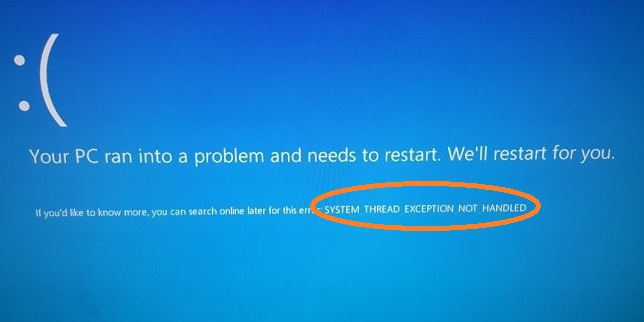

- #Driver thread error windows 10 how to
- #Driver thread error windows 10 drivers
- #Driver thread error windows 10 update
Click "Start" and enter the event viewer. Select "5" or press "F5" to enable Safe Mode with Networking. After the restart, you will see a list of options, as shown in the image below. On the "Choose an option" screen, choose "Troubleshoot" > "Advanced options" > "Startup Settings" > "Restart". Then you will see your computer in WinRE. Press the power button to start the computer, and don't interrupt it this time. Once Windows restarts, hold down the power button for 10s to turn off the computer. Press the power button to start the computer. Once you see the first sign of Windows has started, e.g., the logo of the manufacturer, hold down the power button for 10s again to turn off the device. Hold down the power button for 10s to shut down the computer.
#Driver thread error windows 10 drivers
Since there are multiple disks and drivers on a computer, you first need to specify the drive(or device) or driver that is causing the problem using the Event Viewer. To check it, you need to enter Safe Mode.
#Driver thread error windows 10 update
Given that, the solutions to this issue are quite clear: fix disk corruptions and update the device driver. NTFS_File_SYSTEM (Ntfs.sys)Īs mentioned, the main culprit for a failed Ntfs.sys in such a situation is a file system error, bad sectors, or outdated device drivers. Usually, computer data files may possibly lose after such an NTFS.sys error and EaseUS data recovery software can take good care of it.Įrror Code 1.

#Driver thread error windows 10 how to
How to Recover Files Lost Due to NTFS.sys Errorīefore you fix the missing or corrupt NTFS.sys file in Windows XP/7/8/10, export your data first. Specify the error message on your computer screen and carry out the corresponding fixes to remove the Ntfs.sys error. And the SYSTEM_SERVICE_EXCEPTION (Ntfs.sys) may be induced by antivirus software that is conflicted with the system, corrupted or outdated driver, or problematic RAM sticks. Besides, corrupted hard drive drivers can also result in a failed Ntfs.sys. The culprit for NTFS_File_SYSTEM (Ntfs.sys) is likely to be disk corruption, be it NTFS file system corruption or disk errors like bad sectors. What Caused Failed NTFS.sysĮvery error has its causes. If you receive the error code: SYSTEM_SERVICE_EXCEPTION (Ntfs.sys), you probably get a corrupted system file. Thus, if you get a BSOD with the stop code: NTFS_File_SYSTEM (Ntfs.sys), that means there is something wrong with the hardware driver. Ntfs.sys indicates either the system file that is essential in running Windows or the hardware driver that allows the Windows operating system to read and write to NTFS drives. Ntfs.sys is located in C:\Windows\System32\drivers folder. Check the RAM. Faulty RAM stick installation or incorrect RAM setup may induce an Ntfs.sys. In safe mode, click "Start" and type cmd. Run system file checker tool: DISM and SFC scan. Update Windows. Enter safe mode, click "Start" and type update. Right-click on "This PC" and go to "Manage" > "Device Manager". Update outdated drivers that cause failed Ntfs.sys problem. Open "This PC", right-click the problematic drive. Fix disk corruptions with Windows built-in Chkdsk utility.


 0 kommentar(er)
0 kommentar(er)
